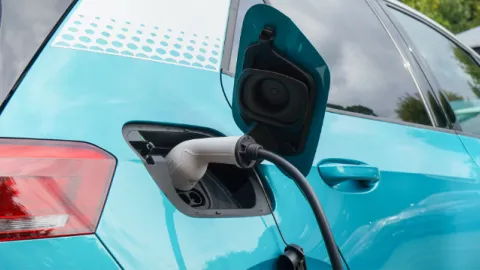
Key data
Duration: 48 months (start date: 1st January 2023)
Overall budget: 9M €
Demonstrators: OPO airport Maia (PT), Budapest (HU), Amsterdam (NL), Isle of Wight (UK), Terni (IT)
Goals
Drive2X will develop new knowledge, tools, models and technology to cope with a V2X-based mass deployment of electric vehicles in Europe. It will also study and consolidate the understanding on the behavioural uncertainties linked to V2X and develop policy tools to support increasingly complex decisions on V2X roll-out in EU smart cities. The project has six main objectives:
- Improve and consolidate understanding of V2X concepts and technologies.
- Identify user experience and behavioural challenges and incorporate into bidirectional charging strategies and algorithms (V2G, V2B, V2H).
- Design and demonstrate a user-centric local V2X marketplace that leverages the flexible energy potential from advanced smart charging in parking lots, homes, and charging stations to optimize welfare for EV owners, building managers, and local distribution network operators alike, while stabilizing the grid and increasing renewable resource utilization.
- Develop and demonstrate novel, affordable, user-friendly V2X solutions and charging technologies while contributing to V2X standardization.
- Assess impacts from mass deployment of V2X technologies on distribution grids and energy markets, as well as potential for promoting renewable energy and decarbonization.
- Support V2X open research activities and market scale-up by developing and making openly available comprehensive models, data sets, and tools.
Highlights
- A user-centric development of V2X solutions
- All demonstration activities coordinated by EDP NEW
- Participation of both EDP NEW (partner) and EDP Labelec (affiliated partner)
- Second project within HORIZON-CL5-2021-D5-01 with EDP NEW as partner
Demonstrators
Isle of Wight, Great Britain
The Isle of Wight is located off the south coast of Great Britain. It has a population of 145,000 and attracts more than 2 million tourists each year. Here, Drive2X will leverage its smart grid infrastructure and strong use of renewables to explore how vehicle-to-grid can support distribution network operations and meet hot water demand in tourism accommodations, with a mix of properties with and without local PV generation. The project will deploy ten V2X chargers in this demonstration and test commercial benefits, increase flexibility on the network, and explore the emergence of a V2G marketplace. It will also test how rate incentives perform in driving charging and how they perform across different audience types. The local leader of this demonstration is the Nottingham Trent University (NTU), with support from the Future Isle of Wight, a community interest company on a mission to improve the local environment and life quality (and a partner in Drive2X).
Maia and Porto, Portugal
In Portugal, the demonstration will take place in two near sites, Maia downtown and Porto Airport (OPO). The first is one of the most industrialised municipalities in Portugal and an important transportation hub, being the first Portuguese city to have a dedicated e-Hub for fast charging EVs located in the city centre. There, Drive2X will deploy its chargers to assess smart charging strategies that support the balancing of the network, like the variable charging power when multiple EV-chargers are connected to a feeder, helping the grid to remain within its intended technical parameters. In the airport, the smart charging strategies are tailored for Vehicle-to-Building (V2B) upon EVs parked while its users are travelling. The rationale is to take advantage of the flexibility provided by the EVs batteries for longer time periods (superior to 24 h) to support the optimal energy management of ANA’s premises, promoting its energy efficiency, green electricity and lower energy costs. For both sites, the project will evaluate rewards schemes to benefit whom engage in these programs and derive techno-economic insights for the national electric mobility regulation.
Amsterdam, Netherlands
Amsterdam has set strong ambitions for clean air, zero-carbon, and liveable car-free city. For electric mobility, these ambitions are increasingly taking effect, resulting in an increased number of public charging points (CP) from 5,000 in 2021 to 18,000 in 2030; private charging reaching 50,000 CP, and in parking lots about 15,000. Along the city’s main ring road (A10), there are Energy and Mobility Hubs (EMH) in strategic locations, which significantly reduce physical mobility; CO2 emissions; car ownership and accelerate Mobility-as-a-Service (MAAS) solutions. DriVe2X will contribute to a larger uptake of innovative V2X cases in these hubs to reduce grid congestion occurrence in different ways. The demonstration shall take place in the south-eastern part of the municipality, in an area that generates high volume car traffic due to sport, music, and leisure events. This hub will feature 850 kWp of PV generation and over 25 % of parking spaces reserved for e-charging, integrated into the existing smart energy grid of the ArenAPoort. The demo plans to involve multiple variables such as generation, consumption, and storage, and will include EVs, E-buses, E-trucks, LEVs, E-bikes, and E-Scooters. Such a highly complex energy ecosystem has a huge potential for upscaling and replication in various settings and sizes.
Budapest, Hungary
Budapest is the capital and most populous city of Hungary, with 690,560 registered passenger cars in 2020, a 23% growth in the last 20 years, and plans to deploy 10 million sqm of solar panels. Life estate owners are interested in adopting renewable and smart energy solutions, like using PVs and other renewable energy sources in a home EV charging scenario that could prevent disruptions in quality of service during peak charging times. Life estate owners in Budapest represent a large portion of EV owners in Hungary, and a network of 2,700+ members called Villanyautósok.hu will conduct a survey with 50 participants to collect data on charging, load curve, EV usage, electric bill balance, and other related factors.
Terni, Italy
Terni, like Maia, will feature two parallel demonstrations realized by ASM. The first is a microgrid comprising two smart charging stations, two PV plants, a second-life battery storage, an office building with a BEMS, and a bio-diesel generator. All these units are monitored by an Advanced Metering Infrastructure. Drive2X will count with a fleet of 10 EVs and will be enriched with a DC branch that creates a hybrid DC/AC microgrid, adding a fast-charging station (50 kW) provided by EMOT. The goal is to demonstrate flexibility through a dynamic bidirectional V2G power exchange. The second aims to demonstrate the grid stability improvement through V2G in potentially congested urban grids.
Role EDP NEW
EDP NEW will lead the work package Testing, validation, and demonstration of V2X solutions in real contexts, covering all the five demonstration sites, including the build of implementation, data monitoring, and risk management plans, synthesis of results and lessons learned evaluation. EDP NEW has a relevant role in tasks related to Drive2X’s foundations; measurements of EV load curves; development of V2G predictive models; chargers’ testing and validation (with Labelec); mass deployment strategies design and contribution to standards and protocols on communications, connectivity, and interoperability.
Partners


